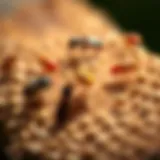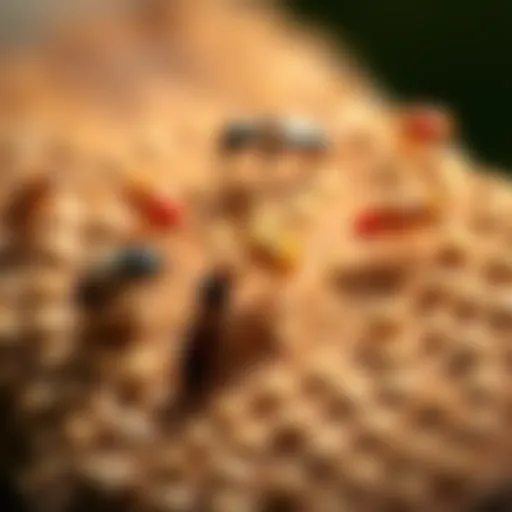Complete Guide to Pest Management in Anne Arundel
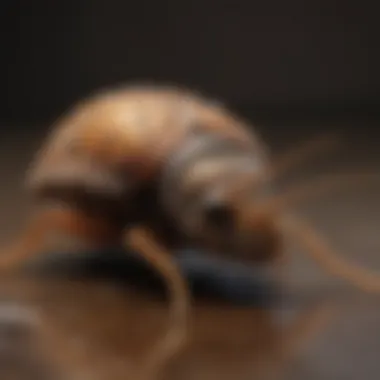

Intro
Pest control is a crucial aspect of maintaining a healthy and comfortable living environment in Anne Arundel County. Homeowners often face challenges posed by common pests that can disrupt daily life. Understanding the types of pests prevalent in the area, along with effective identification and prevention methods, is essential for both comfort and property protection. Further, opting for eco-friendly practices plays a significant role in aligning with the community’s commitment to the environment. This guide serves as a comprehensive resource, providing insights into pest identification, prevention methods, and DIY solutions tailored for residents.
Pest Identification
Common Household Pests
In Anne Arundel County, several pests frequently invade homes, posing various issues for residents. Key pests include:
- Cockroaches: These are often found in kitchens and bathrooms.
- Termites: Known for their destructive feeding habits, they can cause severe damage if not addressed.
- Ants: Various species, including carpenter ants, can create nests inside wooden structures.
- Rodents: Mice and rats are prevalent and can carry diseases.
- Bed Bugs: These pests are difficult to eradicate once they establish in bedding and furniture.
Signs of Infestation
Recognizing the signs of a pest infestation is critical for early intervention. Signs may include:
- Droppings: Small black or brown pellets may indicate rodent activity.
- Gnaw Marks: Visible damage on food packaging or furniture signifies possible rodent presence.
- Shed Exoskeletons: Particularly associated with insects like cockroaches.
- Unusual Odors: Foul smells can indicate pests like rodents or decaying organic matter.
- Visible Damage: Presence of holes or structural damage may be a sign of termites.
"Identifying pests early is key to preventing larger infestations."
Prevention Methods
Environmental Modifications
Creating an environment that is less hospitable to pests is fundamental to prevention. Homeowners should consider:
- Sealing Entry Points: Inspect and seal cracks, gaps, and holes in walls and foundations.
- Proper Drainage: Ensure that gutters and downspouts direct water away from home to avoid creating breeding grounds.
- Yard Maintenance: Regularly trimming bushes and mowing lawns reduces shelter for pests.
Home Maintenance Tips
Routine home maintenance can significantly reduce pest problems. Essential tips include:
- Food Storage: Store food in airtight containers to deter pests.
- Regular Cleaning: Maintain cleanliness, especially in kitchens and dining areas, to eliminate food debris.
- Waste Management: Dispose of rubbish frequently and keep trash bins tightly sealed.
DIY Pest Control Solutions
Natural Remedies
For those inclined toward organic approaches, several natural remedies may help manage pests:
- Vinegar and Water: A mixture can deter ants when sprayed around entry points.
- Diatomaceous Earth: This powder can be sprinkled to kill crawling insects like cockroaches without chemicals.
- Essential Oils: Peppermint and tea tree oils can repel various insects due to their strong scents.
DIY Traps and Barriers
Crafting simple traps can assist in pest control efforts. Consider:
- Homemade Rodent Traps: Using a bucket and a ramp can create an effective trap for mice.
- Sticky Traps: These can capture various crawling insects and are easy to make with non-toxic materials.
Engaging with pest control in a proactive and informed manner is crucial for homeowners in Anne Arundel County. By understanding pest identification and implementing effective prevention methods, one can maintain a pest-free environment while leaning towards sustainable practices.
Understanding the Pest Control Landscape in Anne Arundel County
The pest control landscape in Anne Arundel County reflects the unique challenges and considerations homeowners face in this region. Recognizing the particular pests that thrive in local conditions is essential for any effective management strategy. Local knowledge helps understand when pests are more active and the best methods to mitigate their presence.
Moreover, pest control is not solely about eliminating nuisances; it also involves safeguarding health and property. Pests, such as rodents and insects, can transmit diseases, and their infestations might lead to property damage if not addressed properly. Thus, understanding the local pest landscape becomes a preventative measure that saves homeowners both health risks and financial burdens.
"Pest control is not just about elimination; it is about prevention and protection."
Overview of Local Pest Issues
Anne Arundel County encounters a complex array of pest issues, largely influenced by its varied landscapes and proximity to the Chesapeake Bay. Common pests include termites, which pose a significant threat to wooden structures, and several rodents that may invade homes searching for food and shelter. In the warmer months, mosquitoes and ticks become prominent, raising concerns regarding diseases they can carry.
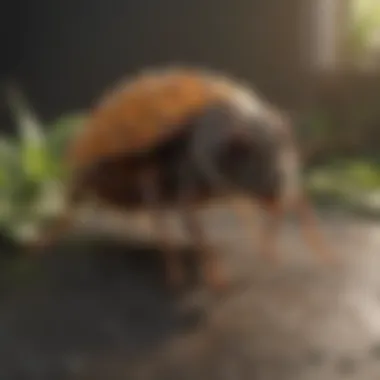

The implications of these pest problems can be far-reaching. For instance, termite infestations can lead to costly repairs due to structural damage. Rodents, on the other hand, can contaminate food supplies, which poses serious health risks. Regular monitoring and identification of these pests can substantially reduce the impact of these issues, making it essential for homeowners to remain vigilant.
Environmental and Climatic Factors Influencing Pests
The environment and climate of Anne Arundel County greatly influence the types and behaviors of local pests. The region experiences a humid subtropical climate, which creates favorable conditions for many pests to thrive. Warm, wet summers contribute to the rapid reproduction of insects like mosquitoes. Additionally, mild winters can lead to pest survival over colder months, resulting in population booms come spring.
Moreover, the presence of diverse ecosystems, such as woodlands, wetlands, and urban areas, provides ample habitats for various pests. Changes in local land use can also impact pest populations. For example, new construction can disturb natural habitats and encourage pests to seek refuge in residential spaces. Understanding these environmental and climatic factors allows homeowners to implement more effective control measures.
Common Pests Found in Anne Arundel
Understanding the common pests in Anne Arundel County is essential for homeowners and pest control providers. Identifying these pests can lead to effective management strategies and preventive measures. Each pest presents unique challenges, and recognizing their behaviors and environments helps in formulating appropriate responses. Moreover, awareness fosters an environment in which residents can maintain healthy and safe living spaces.
Identifying Rodents
Rodents pose significant threats to homes in Anne Arundel. Common species include the house mouse and the Norway rat. These creatures can reproduce quickly, making early identification crucial to prevent infestations. Signs of rodent presence include droppings, gnaw marks, and nests typically found in hidden or cluttered areas.
To effectively control these pests, consider setting traps in locations where droppings are found. Seal entry points in foundations and around utilities to deter rodents from entering the home. Regular monitoring is also key to keep any potential reinfestation at bay.
Insect Infestations
Insect infestations are quite prevalent in Anne Arundel County. Cockroaches, ants, and bedbugs frequently invade residential spaces. Recognizing the signs of these insects aids in timely action. For example, cockroaches often leave dark fecal spots, while ants may form visible trails leading to food sources.
Controlling insect populations necessitates maintaining cleanliness in the home. Regularly clearing food debris, sealing cracks, and utilizing insect baits can greatly reduce the likelihood of infestation. Keeping an organized living space makes it easier to spot any early signs of trouble.
Termite Threats
Termites are among the most destructive pests found in this region. Eastern subterranean termites are particularly notable for their capacity to weaken structural integrity through their tunneling activities. Signs of termite activity include mud tubes, damaged wood, and discarded wings during swarming season.
Prevention strategies include routine inspections of wooden structures and maintaining a dry environment around the home. Homeowners may also apply termite barriers or engage professionals when dealing with existing infestations. Regular vigilance can save significant repair costs in the long run.
Bird Control Issues
Birds, while often considered harmless, can become pests in Anne Arundel when they nest in homes or congregate in large numbers. Species such as pigeons and starlings can cause damage and potentially transmit diseases. Signs of problems include droppings, noise from nests, and visible birds on rooftops or ledges.
Controlling birds often requires a multi-faceted approach. Removing food sources and utilizing physical barriers like netting or spikes can prevent them from settling near homes. Awareness of local bird laws is also critical to ensure compliance while managing these populations.
Pest Identification Techniques
Understanding pest identification techniques is fundamental in pest control management. Identifying pests accurately allows homeowners, pest control professionals, and even researchers to implement suitable management strategies. If the pest is not identified correctly, any attempt at control may be ineffective or harmful.
Some pests are harmless and do not require immediate action, while others can cause significant property damage or health risks. Knowing the right method for identifying these pests can lead to timely solutions.
Visual Identification Methods
Visual identification involves looking at the physical traits of pests. Different pests have distinct characteristics that can help in their identification. Here are some key traits to observe:
- Size and Color: Many pests are recognized first by their size and color. For instance, carpenter ants are usually larger than common house ants and have a black or bicolored appearance.
- Body Shape: The shape of pests can vary greatly. Cockroaches, for example, have a flat, oval shape, whereas bed bugs are more elongated and have a rusty-red color.
- Wings: Some insects, such as termites and wasps, have wings but differ in structure and size. This feature can provide important clues about their identity.
To aid in pest identification, taking clear photographs can be beneficial. These images can then be compared with online resources or sent to local pest control experts for further inspection. Books or online databases can provide guides on local pests specific to Anne Arundel County. Local cooperative extensions often have valuable resources.
Behavioral Observations
Behavioral observations can also play a significant role in identifying pests. Each species displays unique behaviors that can aid in their detection. Observing these actions can lead to a more accurate identification.
- Feeding Habits: Some pests are attracted to wood, while others prefer food items. For example, termites consume wood and can cause structural damage, while mice are scavengers and may be found near food sources.
- Activity Patterns: Noting if a pest is seen mainly at night or during the day can be critical. Many rodents are nocturnal, while ants are generally active during the day.
- Nesting Behaviour: How and where a pest builds its nest can reveal its identity. For instance, rats often nest in hidden areas close to food and water sources, while wasps build their nests in open, sheltered locations.
By combining visual identification methods and behavioral observations, homeowners can pinpoint pests more accurately. This dual approach enhances the effectiveness of pest control strategies implemented subsequently.
Always remember: An accurate identification can save time and resources in the long run.
Prevention Methods
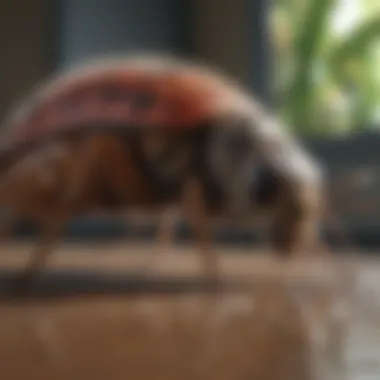

Prevention methods are critical in controlling pest populations, particularly in Anne Arundel County. These methods not only reduce the need for chemical interventions but also promote environmentally responsible behavior. Implementing effective prevention strategies can lead to significant long-term benefits, including reduced pest invasions, lowered health risks, and minimized property damage. Furthermore, understanding these methods allows homeowners to maintain a clean and safe living environment while preserving local ecosystems.
Home Maintenance Strategies
Home maintenance is key to preventing pest issues. Keeping a property clean and well-maintained can deter pests from making it their home. Here are some essential strategies:
- Seal Cracks: Identify and seal all gaps in walls, windows, and doors. This not only helps to keep pests out but also saves energy.
- Proper Waste Disposal: Store garbage in closed containers. Take out the trash regularly to limit food sources for pests.
- Reduce Clutter: Clutter provides hiding places for pests. Regularly decluttering spaces limits potential nesting areas.
- Maintain Landscaping: Trim trees and shrubs. Keeping vegetation away from the home reduces pathways for insects and rodents.
Implementing these strategies creates a less hospitable environment for pests, discouraging them from entering your home.
Using Natural Repellents
Natural repellents can be an effective line of defense against various pests. Utilizing these substances is beneficial for both the environment and human health. Some common natural repellents include:
- Citrus Peels: Many pests, including spiders and ants, dislike the smell of citrus. Placing peels in areas where these pests are prevalent can discourage them effectively.
- Essential Oils: Oils like peppermint, lavender, and eucalyptus serve as deterrents. Applying them in diluted forms around entrances can keep pests at bay.
- Diatomaceous Earth: This natural powder is effective against insects. Sprinkling it in strategic spots disrupts pest exoskeletons, preventing infestations.
These natural methods not only help control pests but also align with sustainable living practices.
Regular Inspections
Regular inspections are an essential part of any prevention strategy. Routine checks can help catch pest problems early before they escalate. Here’s what to focus on during these inspections:
- Look for Signs of Infestation: Check for droppings, chewed items, or nests. Early detection is crucial.
- Inspect Potential Entry Points: Regularly assess doors, windows, and foundation for cracks or gaps that need sealing.
- Monitor Outdoor Conditions: Standing water and overgrown vegetation attract pests. Keep an eye on these areas to prevent breeding grounds.
By scheduling regular inspections, homeowners can save time and money while maintaining a pest-free environment.
Effective prevention minimizes pest issues and supports an eco-friendly lifestyle.
Eco-Friendly Pest Control Solutions
Eco-friendly pest control solutions are increasingly vital in managing pests while focusing on sustainability and environmental health. Traditional pest control methods often rely on chemical products that can have harmful effects on local ecosystems and human health. In contrast, eco-friendly solutions prioritize methods and practices that minimize environmental impact. This is especially important in Anne Arundel County, where communities are becoming more aware of their ecological footprint.
Considerations for choosing eco-friendly pest control include the types of products used, their application methods, and long-term sustainability. Homeowners should seek out products that are labeled as non-toxic and derived from natural ingredients. Moreover, understanding the life cycles and habitats of pests can help implement effective control while using fewer chemicals.
"The shift towards eco-friendly pest control reflects a broader commitment to protecting our environment."
By adopting eco-friendly practices, individuals can reduce the risk of chemical exposure in their homes, safeguard local wildlife, and contribute to healthier communities.
Sustainable Products and Practices
When it comes to sustainable pest control, products and practices are central to achieving a balance between effectiveness and ecological stewardship. Many sustainable pest control products include natural ingredients that disrupt pest life cycles rather than exterminating them outright. For example, essential oils, such as peppermint and clove oil, are known to repel common pests without leaving harmful residues.
Practices such as habitat modification play a substantial role as well. Keeping gardens free of standing water, proper waste management, and maintaining healthy soil can deter pests before they become a problem. Reporting public awareness on these practices increases its effectiveness; community programs can provide valuable insights to residents.
An eco-friendly approach also encourages collaboration with local pest control professionals who specialize in sustainable methods. Homeowners may consider using products like diatomaceous earth, which can eliminate insect pests while remaining safe for pets and humans.
Benefits of Integrated Pest Management
Integrated Pest Management (IPM) represents a holistic approach to pest control that combines various techniques for effective and sustainable management. The primary benefit of IPM is its emphasis on understanding pest life cycles and the ecology of the local environment. This permits targeting specific pests with minimal impact on beneficial organisms and the environment.
Using IPM methods can lead to several key advantages:
- Reduced Chemical Use: The reliance on pesticides decreases, resulting in lower environmental contamination risks.
- Economic Benefits: Sustainable practices often translate to cost savings over time.
- Enhanced Safety: Families and pets are exposed to fewer harmful substances, promoting overall health.
Implementing IPM can start with monitoring pest populations and setting thresholds for action. Homeowners should learn to identify pest symptoms, which may indicate an infestation. By combining cultural, mechanical, and biological controls, effective management can be achieved without heavy reliance on chemicals.
DIY Pest Control Techniques
DIY pest control techniques provide a practical approach for homeowners in Anne Arundel County to manage their pest problems. These methods are often cost-effective and allow individuals to take control of their living environment. Understanding how to tackle pest issues on your own can empower you to keep your home safe and comfortable.
Homemade Pest Solutions


Homemade pest solutions can effectively deter or eliminate common pests without relying on chemical treatments. Many of these solutions utilize everyday household items that are safe for both people and pets. Here are some effective homemade remedies:
- Vinegar Sprays: A mixture of equal parts vinegar and water can act as a repellent for spiders and ants. Spraying this solution in areas where these pests are frequently seen can reduce their presence.
- Essential Oils: Oils such as peppermint or tea tree oil can work wonders. Mix a few drops with water in a spray bottle. Spraying doorways and windows can help deter pests like mosquitoes and flies.
- Boric Acid: When mixed with sugar, boric acid can bait cockroaches. The sugar attracts them, while the boric acid eliminates them. Care should be taken to keep this mixture away from pets and children.
Using these homemade solutions not only addresses pest control issues but also reduces the chemical exposure within your home. Be mindful of where you apply these remedies, especially in areas frequented by children and pets. Regular application might be necessary to maintain effectiveness.
When to Seek Professional Help
Despite the advantages of DIY pest control, there are situations where professional intervention is essential. Here are some indicators that you should contact pest control experts:
- Severe Infestation: If you notice a substantial presence of pests, such as widespread termites or rodents, professionals are better equipped to handle these significant problems safely and effectively.
- Lack of Improvement: If your homemade solutions do not lead to a decline in pest activity, it may be time to consider contacting a professional. Their expertise can provide additional methods and more powerful treatments not typically available to the public.
- Health Risks: Some pests, such as bed bugs or ticks, pose health risks that should be addressed immediately. Professionals have the knowledge and equipment necessary to deal with such pests efficiently.
- Time Constraints: Managing a home and family can be time-consuming. If you find that pest control is taking too much time away from your responsibilities, it may be more practical to hire professionals.
Legal Aspects of Pest Control in Maryland
Understanding the legal framework around pest control in Maryland is crucial for both homeowners and pest management professionals. Compliance with local laws safeguards public health and promotes responsible pest control practices. In Anne Arundel County, regulations are put in place not only to protect residents but also to ensure that pest control measures do not adversely impact the environment. This section explores essential legal considerations and the necessary licenses for pest control practices.
Understanding Local Regulations
Local regulations on pest control can differ significantly from one area to another. In Maryland, the Department of Agriculture oversees pest management activities, dictating specific guidelines for how pest control should be conducted. These guidelines often encapsulate the use of chemicals, safe disposal methods, and the protocols to follow in residential areas.
Key regulatory aspects include:
- Chemical Use Restrictions: Certain pesticide products are prohibited or restricted to minimize risks to human health and the environment. Homeowners should familiarize themselves with these restrictions before application.
- Reporting Requirements: Pest control companies must report certain types of pesticide applications to the Maryland Department of Agriculture. Understanding these requirements can help homeowners know that they are engaging with a compliant service.
- Notification Procedures: Homeowners must be notified if pesticides are being applied inside or around their property, particularly if people or pets will be present. This ensures safety and transparency in treatment methods.
"Adhering to local regulations helps maintain ecological balance while ensuring your household is protected against pests."
Licensing Requirements for Pest Control Professionals
In Maryland, pest control professionals are required to obtain licenses to ensure they are qualified to handle various pest management scenarios safely. This licensing is crucial for several reasons:
- Expertise in Pest Management: Licensing ensures that technicians are trained in effective pest control techniques, understanding pest biology, and the safe application of chemicals.
- Consumer Protection: Homeowners deserve to know that the people working on their properties have met state standards for knowledge and safety.
- Accountability: Licensed professionals can be held accountable for any malpractice, providing homeowners with an avenue for recourse if service quality does not meet expectations.
To obtain a pesticide applicator license in Maryland, applicants must pass an exam that focuses on:
- Pesticide safety
- Environmental protection
- Identification of common pests and their control methods
This ensures that only qualified individuals are allowed to perform pest control operations in residential settings.
Lastly, renewing licenses typically requires ongoing education, which further keeps pest control professionals updated on the latest practices and regulatory changes.
Resources for Further Information
Having access to reliable resources is essential for anyone managing pest control in Anne Arundel County. The field of pest management is constantly evolving, with new pests emerging and innovative strategies being introduced regularly. Homeowners, as well as pest control professionals, can benefit significantly from staying informed and educated about current practices, local issues, and effective solutions. Resources can enhance the understanding of pest behaviors, regional characteristics, and prevention tactics.
Detailed knowledge about pests ensures that both homeowners and professionals can make informed decisions about pest control methods. Having access to diverse forms of information reinforces best practices and promotes a proactive approach. This section explores where one can find valuable insights about pest control specific to Anne Arundel County.
Local Cooperative Extensions
Local Cooperative Extensions are invaluable in providing community-focused resources regarding pest management. These organizations offer a wealth of information tailored to the specific needs and conditions of Anne Arundel County. They conduct research, provide education, and create materials that residents can easily access. For homeowners, this means gaining insights directly applicable to their unique environments.
Services typically include:
- Workshops and Seminars: These events are often held to educate the public on pest identification and control methods. They offer hands-on experiences and direct access to experts.
- Guides and Publications: Cooperative Extensions publish materials that detail pests prevalent in the area. Their guides offer identification tips and control strategies specifically suited for local conditions.
- Diagnostic Services: Homeowners can often submit samples of pests for identification. This service can lead to more targeted and effective management strategies.
To find your local Cooperative Extension, you can visit the Cooperative Extension System website, where you can locate resources pertinent to your county.
Online Databases and Articles
Online databases and articles are becoming increasingly important for anyone interested in pest control. They provide access to up-to-date research, practical advice, and case studies, which can be beneficial in understanding pest behavior and control measures. Reliable online sources can help cover gaps in knowledge that might exist in traditional materials.
Some reliable online resources include:
- Encyclopedia Britannica: This platform offers comprehensive articles on various pest species, including their biology, behaviors, and control methods.
- Wikipedia: Although open to public editing, Wikipedia often provides a good starting point for understanding common pests. It can link you to reputable sources for further reading.
- Research Databases: Many scientific research databases feature studies on pest control. These may provide empirical data and effective solutions backed by research.
In addition to these databases, platforms like Reddit can host community-driven discussions which can also yield valuable tips and insights from shared experiences.
Staying well-informed is integral in making effective pest control decisions. By utilizing local resources and online databases, individuals can equip themselves with the necessary tools to combat pest-related issues effectively.














